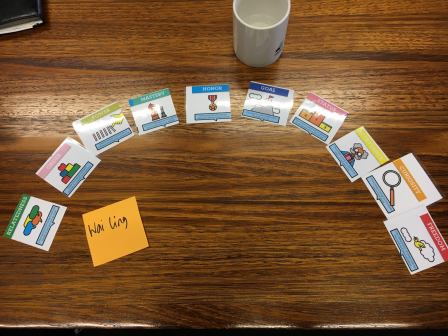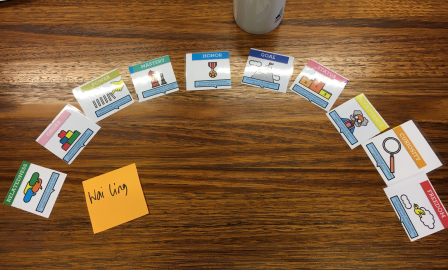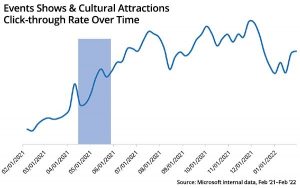— August 21, 2019
At a previous work place, we had copies of Management 3.0 by Jurgen Appelo. The book provides tools and practices that you can apply while managing an organization. We were curious to unpack a couple of the mentioned practices. It happened that we had just some new team members join our team, so at one of our retrospectives, we decided to give Moving Motivators a try. After that session, I ran a couple of more sessions with other teams I was facilitating. Having experienced a couple of sessions both as a participant and as a facilitator, I am going to share how we prepared and ran the exercise followed by what we learned.

How we prepared Moving Motivators
We wanted the team to explore what motivates each and everyone of us and to get to know each other better. As a participant, there is nothing you have to prepare before going into the exercise. As a facilitator, preparation is key. Here are the key tasks that I prepared as a facilitator.
Preparing the flow of the session
With the goal in mind, preparing the flow of the session would was most important. As a facilitator of one of the sessions, I read the Moving Motivators material on the Management 3.0 website. What I found most valuable was the short video on explaining the flow of the exercise and meaning of each of the cards. I knew we had 60 minutes and 8 participants and I decided on the rough break down of the agenda. I also prepared a list of supporting questions that I added to help us in case conversations get stuck during the exercise:
- Ice breaker – question (7 minutes): Think about the most exciting and motivational piece of work/task that you ever completed: What made you be so excited about it? (2 minutes individual brainstorm, 5 minutes going around the room sharing)
- Explain purpose of session and exercise (7 minutes): reconnect with icebreaker touching on motivators, explain goal of session, hand out cards, go through each card.
- Individual card sort (8 minutes): read the cards and ask everyone to do an individual brainstorm and sort the cards.
- High level share and explore each individual (20 minutes): each individual shares their card sort. Record data on a whiteboard in a table grid (list of motivators/participant name). Ask some of the following questions to kickstart the conversation and let the room ask questions to the individual as well:
- Tell me more about your top-3 motivators: Can you share an example of a situation where you a top motivator came into play?
- How do we notice when a motivator that scored low for you comes into play?
- What do you want others to be aware of when we are discussing a new piece of work?
- Deeper exploration as a group (15 minutes): explore observations on team level.
- What do you notice in our team? What are some patterns you notice?
- Any patterns across top/lower motivators? What are patterns you notice when looking at motivators that you found less important? What could be impact of having some motivators on the lower end?
- What are outliers that you notice?
- Knowing what we shared, what do you think we need to have on top of our mind when discussing new pieces of work in future?
- Wrap up (3 minutes): Recap high level findings and propose future ways to reconnect. Take pictures of individual card sorts, share data collected later.
Preparing material and location
I printed out the cards in full colour on A4 and laminated them so they would be easier to handle and could be reused with other groups later. I ensured that we had 1 deck of cards per participant and a spare set. For the location, consider the following:
- Find a space where everyone has a seat with enough space so they can lay out all their cards on the table or find a space where everyone has enough space to stick their cards up to a wall. We went for seats at a table.
- A space where you can create a table grid (overview motivators/participants), can be a whiteboard or flip chart.
- A whiteboard or flip chart to take notes of the conversation.
- There is no need for a laptop or computer.
How we ran the Moving Motivators exercise
All our participants were co-located so I ran the exercise in a room where everyone was physically present. Here are some observations I had while running the exercise:
Finding a suitable icebreaker gets participants connected
I opened the session with an icebreaker question. While preparing, I ensured the icebreaker was on-point and related towards the theme. In this case, I asked everyone to share an example where they felt motivated around a piece of work. I found that using the right icebreaker, warms the group up towards the theme of rest of the session and people have a connection with the topic from the start.
Easy way to do valuable individual reflection
Exploring motivators of the participants in the room is at the core of Moving Motivators. The exercise was simple enough, that participants didn’t need much explanation to do their own individual reflection. Participants individually reflecting and ranking the motivators created lightbulb moments in itself for many, as many participants haven’t taken time to reflect in the past. Having the paper cards made it very tactile and tangible, and contributed to the ease of playing the exercise.
Balancing between sharing as an individual and reflection as a group
Although we planned for an hour with a prepared agenda, I felt there was more to explore than we had time for. I had 8 people in the room and my job was to ensure that everyone was being heard. I felt myself continuously balancing between further excavating what individual was sharing and ensuring equal turn taking. With 8 people there is a lot of content that could be explored and I soon found out that we wouldn’t have enough time to finish what I had in mind for deeper exploration as a the group. I choose to spend more time on deepening the knowledge sharing of each individual to the group. This meant I had less time for deeper exploration as a group.
Deeper exploration as a group
By spending time on reflection on motivators as a group, the participants discovered what they had in common. They noticed patterns of similar motivators ranking high or low in the group. It triggered participants to think about how to communicate work to each other and provided insights into why people are excited about work. There were participants who noticed outliers, which translated into potential strengths to consider when thinking about different pieces of work.
Wrapping up
As a facilitator I took photos of each the sorted cards of each participant and I transferred the collected data to an electronic document. I shared both photos and documents back to the group so they could use it as a future reference.
What would I do differently next time?
I found the Moving Motivators exercise very easy to set up: You only have to print the cards which is low-cost and find a room that fits everyone in. At most companies, you will have access to these resources. After having run Moving Motivators a couple of times, I will share some learnings I would take into account for future runs.
There are no wrong/bad or right/good motivators.
It is essential to explain there are no bad or good motivators and that individuals will not be judged on how they order their motivators. What motivates people is complex: people want autonomy, have innate desire to do well and use self-direction to accomplish objectives. Purpose is to get insight of what gets you engaged and what conditions need to be created to support you.
Agree on meaning of Motivator cards
Spend some time on going through the meaning of the cards and agree on the meaning of a card before going into the individual reflection. The Power card raised most questions, perhaps start with that one. There is no right or wrong definition of a Motivator, goal is to align on a definition that works for the group
Individual card sort was a light bulb moment in itself
As I mentioned before, there is a lot to explore. I have noticed that it was the first time for many participants to do an individual reflection on their motivators. If you are going to run a session with a group, allow yourself enough time for individual reflection and exploring Motivators for each participant. Allow time for others to be curious and ask questions to the person sharing.
Future opportunities to explore
I didn’t have a chance yet to explore opportunities to hook back into the Moving Motivators. A couple of ideas that immediately jump into mind, where the motivators can reference: During 1-on-1 conversations with individual team members, anytime discussing future pieces of work and referencing the Moving Motivators in reflections in a retrospective.
I hope that I have encouraged you to run a session yourself. Feel free to contact me if you have any questions.
Business & Finance Articles on Business 2 Community
(54)
Report Post



